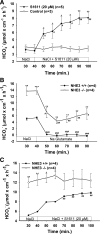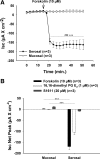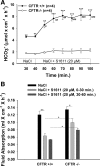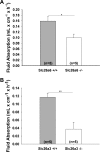The switch of intestinal Slc26 exchangers from anion absorptive to HCOFormula secretory mode is dependent on CFTR anion channel function
- PMID: 20164375
- PMCID: PMC2867396
- DOI: 10.1152/ajpcell.00454.2009
The switch of intestinal Slc26 exchangers from anion absorptive to HCOFormula secretory mode is dependent on CFTR anion channel function
Abstract
CFTR has been recognized to function as both an anion channel and a key regulator of Slc26 anion transporters in heterologous expression systems. Whether this regulatory relationship between CFTR and Slc26 transporters is seen in native intestine, and whether this effect is coupled to CFTR transport function or other features of this protein, has not been studied. The duodena of anesthetized CFTR-, NHE3-, Slc26a6-, and Scl26a3-deficient mice and wild-type (WT) littermates were perfused, and duodenal bicarbonate (HCO(3)(-)) secretion (DBS) and fluid absorptive or secretory rates were measured. The selective NHE3 inhibitor S1611 or genetic ablation of NHE3 significantly reduced fluid absorptive rates and increased DBS. Slc26a6 (PAT1) or Slc26a3 (DRA) ablation reduced the S1611-induced DBS increase and reduced fluid absorptive rates, suggesting that the effect of S1611 or NHE3 ablation on HCO(3)(-) secretion may be an unmasking of Slc26a6- and Slc26a3-mediated Cl(-)/HCO(3)(-) exchange activity. In the absence of CFTR expression or after application of the CFTR(inh)-172, fluid absorptive rates were similar to those of WT, but S1611 induced virtually no increase in DBS, demonstrating that CFTR transport activity, and not just its presence, is required for Slc26-mediated duodenal HCO(3)(-) secretion. A functionally active CFTR is an absolute requirement for Slc26-mediated duodenal HCO(3)(-) secretion, but not for Slc26-mediated fluid absorption, in which these transporters operate in conjunction with the Na(+)/H(+) exchanger NHE3. This suggests that Slc26a6 and Slc26a3 need proton recycling via NHE3 to operate in the Cl(-) absorptive mode and Cl(-) exit via CFTR to operate in the HCO(3)(-) secretory mode.
Figures










Similar articles
-
Molecular transport machinery involved in orchestrating luminal acid-induced duodenal bicarbonate secretion in vivo.J Physiol. 2013 Nov 1;591(21):5377-91. doi: 10.1113/jphysiol.2013.254854. Epub 2013 Sep 9. J Physiol. 2013. PMID: 24018950 Free PMC article.
-
PAT-1 (Slc26a6) is the predominant apical membrane Cl-/HCO3- exchanger in the upper villous epithelium of the murine duodenum.Am J Physiol Gastrointest Liver Physiol. 2007 Apr;292(4):G1079-88. doi: 10.1152/ajpgi.00354.2006. Epub 2006 Dec 14. Am J Physiol Gastrointest Liver Physiol. 2007. PMID: 17170027
-
CFTR and its key role in in vivo resting and luminal acid-induced duodenal HCO3- secretion.Acta Physiol (Oxf). 2008 Aug;193(4):357-65. doi: 10.1111/j.1748-1716.2008.01854.x. Epub 2008 Mar 21. Acta Physiol (Oxf). 2008. PMID: 18363901
-
Effects of Slc26a6 deletion and CFTR inhibition on HCO3- secretion by mouse pancreatic duct.J Med Invest. 2009;56 Suppl:332-5. doi: 10.2152/jmi.56.332. J Med Invest. 2009. PMID: 20224218 Review.
-
The SLC26 gene family of multifunctional anion exchangers.Pflugers Arch. 2004 Feb;447(5):710-21. doi: 10.1007/s00424-003-1090-3. Epub 2003 May 21. Pflugers Arch. 2004. PMID: 12759755 Review.
Cited by
-
Advances in Ca2+ modulation of gastrointestinal anion secretion and its dysregulation in digestive disorders (Review).Exp Ther Med. 2020 Nov;20(5):8. doi: 10.3892/etm.2020.9136. Epub 2020 Aug 25. Exp Ther Med. 2020. PMID: 32934673 Free PMC article. Review.
-
p38 MAP kinase and MAPKAP kinases MK2/3 cooperatively phosphorylate epithelial keratins.J Biol Chem. 2010 Oct 22;285(43):33242-33251. doi: 10.1074/jbc.M110.132357. Epub 2010 Aug 19. J Biol Chem. 2010. PMID: 20724476 Free PMC article.
-
The digestive tract as an essential organ for water acquisition in marine teleosts: lessons from euryhaline eels.Zoological Lett. 2021 Jun 21;7(1):10. doi: 10.1186/s40851-021-00175-x. Zoological Lett. 2021. PMID: 34154668 Free PMC article. Review.
-
Myosin Ia is required for CFTR brush border membrane trafficking and ion transport in the mouse small intestine.Traffic. 2012 Aug;13(8):1072-82. doi: 10.1111/j.1600-0854.2012.01368.x. Epub 2012 May 8. Traffic. 2012. PMID: 22510086 Free PMC article.
-
The distinct roles of anion transporters Slc26a3 (DRA) and Slc26a6 (PAT-1) in fluid and electrolyte absorption in the murine small intestine.Pflugers Arch. 2014 Aug;466(8):1541-56. doi: 10.1007/s00424-013-1381-2. Pflugers Arch. 2014. PMID: 24233434 Free PMC article.
References
-
- Alper SL, Stewart AK, Chernova MN, Zolotarev AS, Clark JS, Vandorpe DH. Anion exchangers in flux: functional differences between human and mouse SLC26A6 polypeptides. Novartis Found Symp 273: 107–119, 2006 - PubMed
-
- Ameen N, Alexis J, Salas P. Cellular localization of the cystic fibrosis transmembrane conductance regulator in mouse intestinal tract. Histochem Cell Biol 114: 69–75, 2000 - PubMed
-
- Broere N, Chen M, Cinar A, Singh AK, Hillesheim J, Riederer B, Lunnemann M, Rottinghaus I, Krabbenhoft A, Engelhardt R, Rausch B, Weinman EJ, Donowitz M, Hubbard A, Kocher O, de Jonge HR, Hogema BM, Seidler U. Defective jejunal and colonic salt absorption and altered Na+/H+ exchanger 3 (NHE3) activity in NHE regulatory factor 1 (NHERF1) adaptor protein-deficient mice. Pflügers Arch 457: 1079–1091, 2009 - PMC - PubMed
Publication types
MeSH terms
Substances
Grants and funding
LinkOut - more resources
Full Text Sources
Molecular Biology Databases

